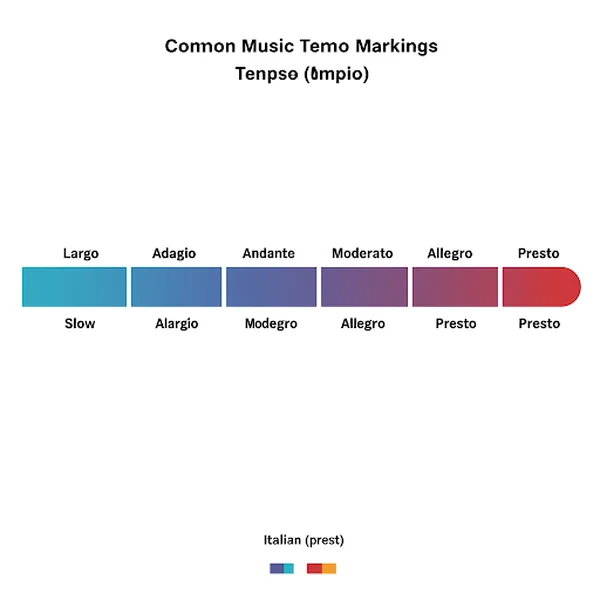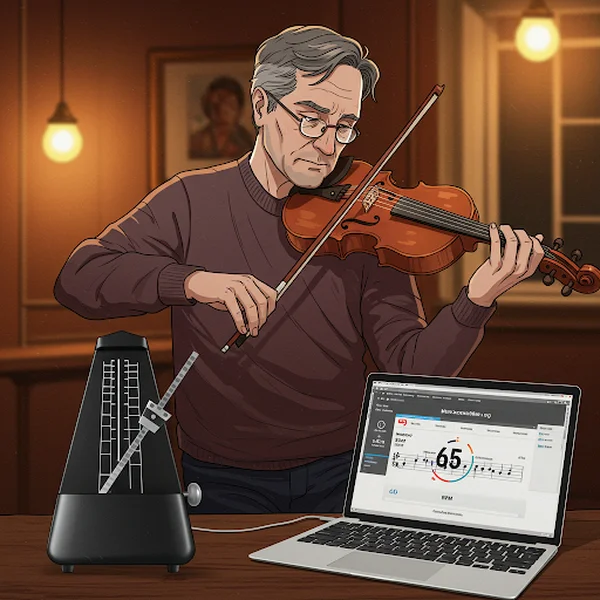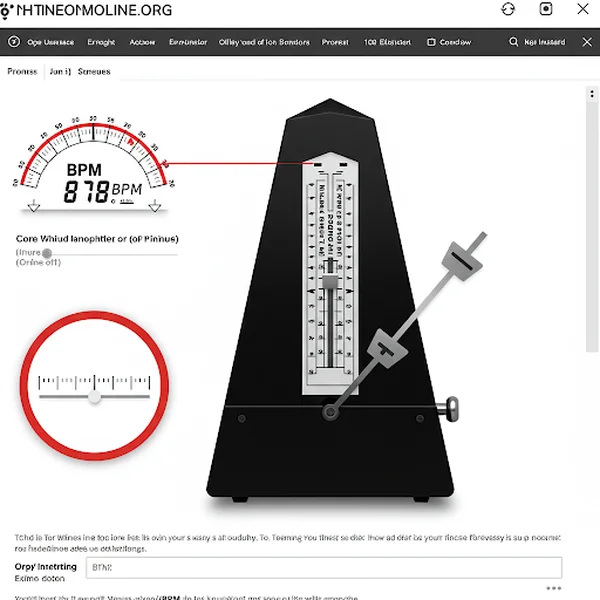Understanding BPM & Tempo Markings: Find Your Perfect Speed
Tempo – the speed of music – is fundamental to how a piece feels and is performed. But how do musicians accurately measure and communicate this speed? That's where BPM comes in. What is bpm? Understanding the bpm meaning (Beats Per Minute) and deciphering tempo markings on sheet music are crucial skills for any musician aiming for rhythmic precision. This guide will demystify these concepts and help you choose tempo effectively for your practice sessions, using a reliable metronome tempo from an accessible online tool like ours. Ready to dial in your perfect practice speed? Explore our online metronome to get started.
What Exactly is BPM (Beats Per Minute)? The Heartbeat of Tempo
Let's start with the basics. What is bpm? BPM stands for Beats Per Minute, and it's the standard unit used to measure the tempo, or speed, of music. It literally tells you how many steady beats occur within one minute.
Defining the Unit of Musical Speed
Think of BPM as the precise numerical value for music speed. A lower BPM number means a slower tempo, while a higher BPM number indicates a faster tempo. This quantification is essential for setting your metronome accurately and ensuring you're practicing at the intended pace. It provides a clear tempo definition that removes ambiguity.
How BPM Translates to Fast or Slow
The difference becomes obvious with examples. A tempo of 60 bpm means there is exactly one beat every second – a relatively slow, deliberate pace often associated with ballads or slow movements. In contrast, 120 bpm delivers two beats per second, creating a much more energetic and common tempo found in many pop and rock songs. Higher values like 180 BPM or even faster represent very quick tempos.

The Foundation for Your Metronome Setting
Ultimately, the BPM value is the core number you'll input into your metronome, whether it's a physical device or an online metronome. Knowing the target BPM allows you to set your metronome tempo correctly, providing the steady click you need for effective rhythm training. Access our precise metronome to set any BPM you need.
Why Understanding Tempo Markings is Crucial for Musicians
While BPM provides a precise number, musical scores often use descriptive words, usually in Italian, known as tempo markings. Why is tempo important in music? Because these markings go beyond just speed; they offer vital clues about the character, mood, and intended feeling of the music.
More Than Just Speed: Conveying Mood
A marking like Adagio (slow) suggests not only a slow pace but often a mood of calmness or seriousness. Conversely, Allegro (fast) implies brightness and energy. Understanding these nuances, informed by the tempo markings, allows for a much richer and more expressive performance than simply playing at a set BPM number would achieve.
Communicating the Composer's Intent
Composers use tempo markings as a primary way to communicate their vision for the piece. Ignoring or misinterpreting these markings can lead to a performance that doesn't align with the composer's original artistic idea. Accurately interpreting the intended music tempo is key to faithful execution.
Achieving an Authentic Performance
Correctly applying both the speed and the implied character of tempo markings contributes significantly to an authentic and convincing musical performance. It shows a deeper understanding of the musical language and respect for the score.
Common Music Tempo Terms Explained (Largo to Presto)
Let's decode some of the most frequently encountered Italian tempo markings. What are common tempo markings? While BPM ranges can vary slightly depending on context and historical period, these provide a general guide:
Largo & Adagio: The Slow End of the Spectrum
- Largo: Broadly, very slow (typically ~40-60 BPM). Often implies grandeur. (Largo tempo)
- Adagio: Slowly, at ease (typically ~66-76 BPM). More flowing than Largo.
Andante: At a Walking Pace
- Andante: At a walking pace (typically ~76-108 BPM). A moderate, flowing tempo. (Andante tempo) This is a very common and versatile marking. What does andante tempo mean? It signifies a comfortable, unhurried speed.
Moderato: The Middle Ground
- Moderato: Moderately (typically ~108-120 BPM). The neutral middle ground of tempo. (Moderato bpm)
Allegretto & Allegro: Getting Faster and Livelier
- Allegretto: Moderately fast, fairly lively (typically ~112-120 BPM). A bit slower and lighter than Allegro.
- Allegro: Fast, quick, bright (typically ~120-156 BPM). Very common, energetic tempo. (Allegro bpm) How fast is allegro? Generally, it's considered quick and lively.
Presto: Very Fast!
- Presto: Very fast (typically ~168-200 BPM or even higher). Indicates high speed and excitement. (Presto bpm)
Approximate BPM Ranges for Tempo Markings
Remember, these BPM ranges are guidelines, not rigid rules. The exact music speed can depend on the piece's style, complexity, and the performer's interpretation. However, these terms provide essential direction for setting your initial metronome tempo.

How to Choose the Right Metronome Tempo for Practice
Okay, you understand BPM and tempo markings. Now, how do i choose a practice tempo? Selecting the right speed for your practice session is key to making progress. Here’s how to approach it:
Reading the Score: Following Explicit Instructions
If your sheet music has a specific BPM number (e.g., ♩ = 100) or an Italian tempo marking (e.g., Allegro), start there. This is the composer's or editor's intended speed and your primary guide.
Using Your Ears: Listening and Feeling the Tempo
If there's no marking, listen to recordings of the piece if available. Get a feel for the established tempo. If no recording exists, rely on your musical intuition and the character of the piece to determine an appropriate starting music tempo. You can even use a Tap Tempo tool to find the BPM of a recording.
Slowing Down for Accuracy: The Practice Tempo Strategy
This is crucial! Don't feel obligated to immediately practice at the final performance tempo. It's often much more effective to choose a significantly slower practice speed using your metronome. This allows you to focus on accuracy, technique, and clean execution of difficult passages before gradually increasing the metronome tempo.

Consulting Your Teacher or Resources
Your music teacher is an invaluable resource for guidance on appropriate tempos. They can assess your current level and suggest suitable practice speed targets for specific pieces or exercises. Online forums and musical resources can also offer insights.
Setting Your Chosen Tempo on MetronomeOnline.org
Once you've decided on your target BPM, setting it on our online tool is straightforward. Can i set any bpm on an online metronome? Yes, within a very wide practical range.
A Quick Guide to Our Online Metronome Controls
Navigate to the Metronome Online homepage. You'll find clear controls, usually a slider, +/- buttons, or a number input field specifically for the BPM value.
Inputting Your Target BPM Accurately
Use the controls to dial in the exact BPM number you decided upon, whether it's 60 bpm, 120 bpm, or any other value derived from the tempo markings or your practice strategy. Press 'Start', and you'll have a steady beat at your chosen metronome tempo.

Master Tempo Control: Set Your Perfect Pace with Our Metronome
Understanding the bpm meaning and deciphering tempo markings empowers you to approach music with greater accuracy and expressiveness. Knowing how to choose tempo strategically for practice is equally vital for steady improvement. By combining this knowledge with a reliable tool like the free online metronome available here, you gain precise control over your practice speed, laying a solid foundation for rhythmic mastery.
Don't let tempo be a mystery. Use these insights to inform your practice. Set your metronome, focus, and feel the difference that precise timing makes.
Your BPM & Tempo Questions Answered
Here are answers to some common questions about BPM and tempo:
-
How fast is Allegro in BPM, approximately?
Allegro bpm typically falls in the range of 120-156 BPM, indicating a fast, bright, and lively tempo. The exact speed can vary based on the specific piece.
-
What does the Andante tempo marking really mean?
Andante tempo signifies a moderate speed, often described as "at a walking pace." It suggests a flowing, unhurried feel, generally between 76-108 BPM.
-
Is 120 BPM considered a fast tempo in music?
Yes, 120 bpm is generally considered a moderately fast to fast tempo. It's very common in pop, rock, and dance music and corresponds roughly to an Allegro marking.
-
How do I find the exact BPM of a song I like?
The easiest way is often to use an online Tap Tempo tool, like the one available here at Metronome Online. You tap along with the beat, and the tool calculates the BPM for you.
-
Can I practice a piece slower than the indicated tempo marking?
Absolutely! Practicing slower than the marked tempo is a highly recommended strategy. It allows you to focus on accuracy and technique before gradually increasing the practice speed towards the final goal using your online metronome practice tool.